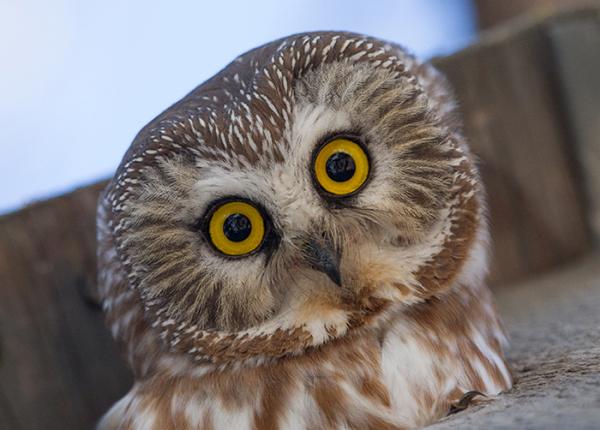Four of us were lucky to spend 45 minutes on an October morning with a Northern saw-whet owl along the high Cascade crest. Conifer trees behind it made a muted blue background. Soon after its photo was taken, the owl swooped down with frost flying off its head - like it was flying in stars…
Found on flickr


I love those little guys and their big googly eyes. 😍
I liked his description of the frost poof, and saw he does have photos of that too!
Thans for the post!
That is a lovely photo!
I’ve been whizzing through suitable images to post and hadn’t seen that one yet…So jealous of the action shot 👍
He’s got one that’s less cropped than this one too, I just went with this one to see that big silly face better. 😜
There are so many good photographers out there! I just want to be able to see some wild owls in person.
I’ve managed to see a resting Tawney perched on a building, who was quite happy to remain stationary while I shone a torch at it…usually it’s a blink and I miss it as they fly past.
I have had a Barn Owl appear in front of me like a ghost, just as I shit my pants.
Having a dog helps, I’ve seen all sorts of critters whilst going out for an evening pee and a poop (the dog, not me)
I only ever got to see a Barn Owl on our fence about 30 years ago.
Where I live now, we have the Great Horned Owls I hear, and I love their hooting, but they keep away all the other owls, so it greatly reduces my odds of actually seeing one.
I do miss my late night dog walks. I used to like watching the bats do figure-8s swooping up all the bugs.
I used to have Great Horned Owls by me (in the suburbs!). I would hear them in the evening and early morning, but I haven’t for the past couple years. Apparently, they nest early, like February? Maybe I’ll hear some this year or the raspberry pi will pick them up.
I’ve stressed that before when city people say they’ll never see an owl, owls are everywhere people are, because that’s where the rodents are, and where there’s tasty rodents they’ll be hungry owls to welcome them!
Some owls are deeeeeep woods creatures, but many have evolved to live better nearby to people. As I said, the rodents gather around all our food, and our clearing trees and maintaining fields and orchards give them nice places to sit up high, yet monitor a nice clear open area to fly. Little Owls are big fans of us humans, and I know I’ve posted some Australian studies about how Powerful Owls are adapting as cities and towns expand into their hunting areas.
Nesting depends on many conditions, since GHO are found over a wide range of ecosystems. From Wikipedia:
There are a lot of tall oaks and squirrels in my yard. I’ve see hawks too!
Seriously??? How does this work?
You can set up a raspberry pi and microphone to listen for and identify birds in your yard. Here is a website that explains how to do it: https://becausebirds.com/fun-raspberry-pi-project-identify-backyard-birds-24-7/
This is amazing, I’m bookmarking it for future reference, now I just need an idiots guide to Pi
What birds have you picked up on it?
I dont know if this is what they have, but BirdNET-Pi is the first thing that comes to mind.
Classify birds acoustically with BirdNET-Pi
Cornell also has it in app form if you want to play with it on a phone/tablet.
I haven’t tried it at all, so I’m curious how well it works as well!
WOW!! I had no idea this existed, I’m seriously impressed!
I have been looking At Raspberry Pi for a while, but it would be a bit of a slog for me to get my head round it all…BUT, one day I’m going to find an idiots guide and dip my toe in the water